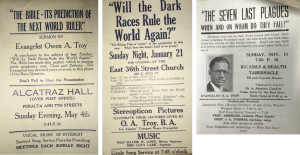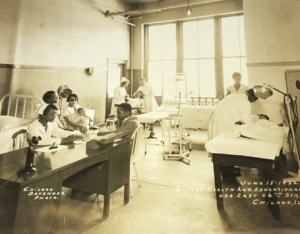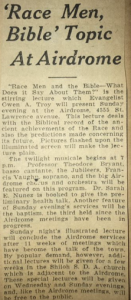4 Chapter 4
Troy’s works at Market Street gained him recognition amongst the SDA elites and by the mid-winter of 1931 he was called to Chicago to lead the Shiloh Tabernacle Church, which had become “like a ship without a rudder.” Recommended by Frank L. Peterson, the same Peterson who had been the first African American graduate from Pacific Union College, the Shiloh Church remembered his appointment “[a]s David was called of God from the tending of his sheep, so Eld. Owen A. Troy was called [to Shiloh].”[1] Here, Troy was able to extend the works of the church to the wider community, with a “three-fold vision” involving the establishment of a Health and Educational Clinic, as well as extended evangelistic campaign, not dissimilar to the famed lecture series started at Market Street. As one newspaper columnist, H. E. Ford, wrote, membership of Shiloh increased from 394 to 452 as a result of Troy’s pastorship. Another important aspect of Troy’s time in Chicago was ability to adapt his methods to meet the needs of his changing congregations, including the increasing proportion of West Indians and members emanating from the American Southern.[2]

Troy’s move to Chicago occurred in parallel to the Great Depression: with the Wall Street Crash occurring in September of 1929 and the bulk of Roosevelt’s New Deal coming in 1933, Troy’s health and educational clinics in Los Angeles and Chicago were vital ventures for the public. Upon leaving Los Angeles in 1931, approximately one in three of his African American congregation members were unemployed as a result of the Crash.[3] According to one study, African Americans during the early years of the Great Depression in California relied heavily upon the services of churches; from clothing collections to food production, places like Market Street, and later Shiloh in Chicago, provided essential services for the community that government or state aid lacked.[4] Other organizations, like the Alphabet Agencies and the NYA Division of Negro Affairs, headed by Mary McLeod Bethune, also aided the population through this difficult time. In California and Chicago, state divisions relied upon the philanthropy of women’s clubs to distribute aid to its citizens. In California, for example, this involved the California Federation of Colored Women’s Clubs encouraging participation in NYA initiatives.[5] Ruby Troy, being an active member in women’s organizations in both California and Chicago, was likely involved in these programs and is credited for conducting the first SDA vacation Bible school. Moreover, given the Seventh-day Adventist dedication towards community wellbeing, Market Street’s Bible and Heath Chautauqua and Shiloh’s Health and Educational Clinic, as well as classes in nursing and cooking, were highly beneficial given the economic situation. The Dorcas Welfare Society for example, a chapter of which is organized in every SDA church, has a legacy of aiding the congregation and extended community, through clothing, food boxes and healthcare.[6] Furthermore, with long-held advocacy for community food courts, recommended by White and John E. Fulton to accommodate the Seventh-day Adventist diet, the church was well-equipped to aid the local community. Health food store and vegetarian cafeterias opened in many of the major SDA urban communities in the United States in the opening decades of the twentieth century, but this idea rapidly extended during the Great Depression; several Penny-A-Dish Cafes were opened in cities including Los Angeles, where hundreds of residents were fed warm and healthy meals by SDA congregational members.[7] The Shiloh Clinic, established April 1932, provided upwards of 10,000 patients medical and dental care within three years of opening, with the Pittsburgh Courier declaring it “a shining example of community service.”[8] Thus, Market Street’s initiatives in healthcare, education and food supplies were essential programs for aiding the local community through the beginnings of the Great Depression.
Another remarkable aspect of Troy’s pastorship of Shiloh was his “Airdome Meeting Series,” a twelve-week program which involved gospel and health lectures held outside in a large “airdome” tent on St. Lawrence Avenue, a few miles from the church. Troy was accompanied by doctors, nurses and dieticians in this venture to provide free informative sessions for the general public. The pavilion hosted a range of lectures by Troy, health clinicians, as well as praised musicians. Troy’s “illustrated lectures” incorporated screen pictures for viewing whilst he preached on subject from “Another King Soon to Rule the World According to Bible Prediction” to “Did God Place A Curse Upon The Darker Races?,” and “Midnight Love”.[9] One report claims 1,100 attended Troy’s opening lecture in July 1935, and five weeks later that number swelled to 1,500 when the famed Alabama Singers made an appearance at the Airdome.[10] Equipped with advanced audio technology, necessary to fill the thousand-person outdoor pavilion, Troy addressed “World problems, and the meaning and remedy for the present upset condition in the world, and the future and destiny of the civilization.”[11] Troy’s passion for music was also a significant feature in the


airdome series, with each evening ending on a Twilight Musicale, attracting groups from Oakwood Junior College, as well as the Federal Glee Club, in a one hundred person orchestral stage. The meetings were extended to twelve weeks on account of an outstanding community engagement.
Juggling a pastor position at Shiloh, countless community engagement commitments, and a family of his own, Troy also graduated from the University of Chicago with a master’s degree in religious education in 1938. The second African American graduate from Chicago, Troy’s thesis was titled “A Study of Tithing as Practiced by Seventh-day Adventists.” The following summer in 1939, Troy joined childhood friend Adolphus E. Webb in St. Louis for a series of evangelical lectures. Commenting on his first impressions of St. Louis in a letter, Troy wrote: “I find St. Louis a far better place than I anticipated. Externally, at least, the Negros don’t seem to be so bad off.”[12] Troy’s purpose in the city, the “Tent Services,” ranged from heath concerns and treatments to diet choices and achieved immense success. Those delivered by Troy and Webb, which “prov[ed] to be the greatest opportunity that the people of St. Louis have had for some time to gain a clear concept of what the Bible really teaches.”[13] Differing from the more common style, the lectures were reported to have been “vastly different … and, because of their high caliber, appealing to intelligent, opened minded St. Louisans” on topics of which they were “anxious to be informed.”[14] The short “Big Tent” series of lectures therefore provided Troy with a platform to preach his intellectual and evangelist ideas to a far larger audience than at Shiloh; Troy’s career was beginning to flourish by 1939, with extensive publicity on his evangelical and musical talent.
[1] Newspaper report, H. E. Ford, concerning 1931 Chicago Church. Sourced from Owen A. Troy Sr. Private Collection. Pics: 1931 Chicago Church.
[2] Newspaper, Pics 1: 1931 Chicago Church, December 1988: North American Regional Voice.
[3] El Dorado: p.23.
[4]Brooks De Graaf, Mulroy, and Taylor: 24.
[5] El Dorado p.23-4.
[6] Haussler, “The History of the Seventh-Day Adventist Church in California”: 300.
[7] Ibid.: 312.
[8] Sydney Freeman, Jr., and Chloe O’Neill, “Troy, Owen Austin, Sr. (1899-1962).”
[9] Appendix: 1. Sourced from Owen A. Troy Sr. Private Collection. Personal photograph.
[10] Ibid.
[11] Ibid.
[12] Letter to Claude Barnett of The Associated Negro Press in 1939, sourced from Owen A. Troy Sr. Private Collection.
[13] “Unusual Services Featured At Tent Meet of Adventists,” newspaper clipping from 06/13/39, in Owen A. Troy Sr. Private Collection.
[14] “Big Meetings Continue At Big Tent; Big Tent Meetings Thrill St. Louisans,” newspaper report in Owen Troy, Sr. Private Collection.

